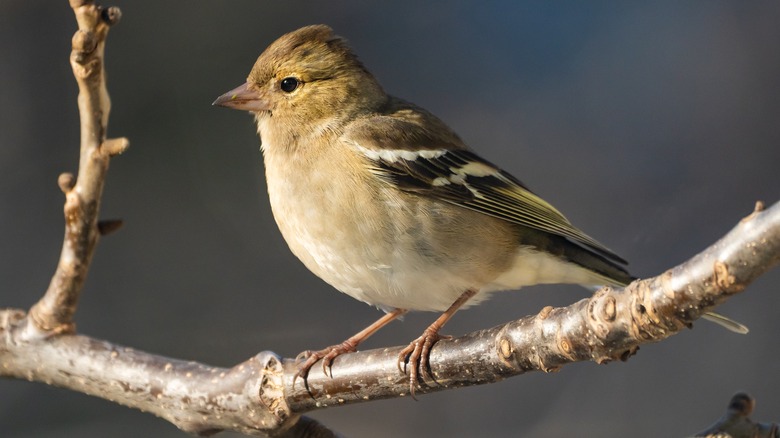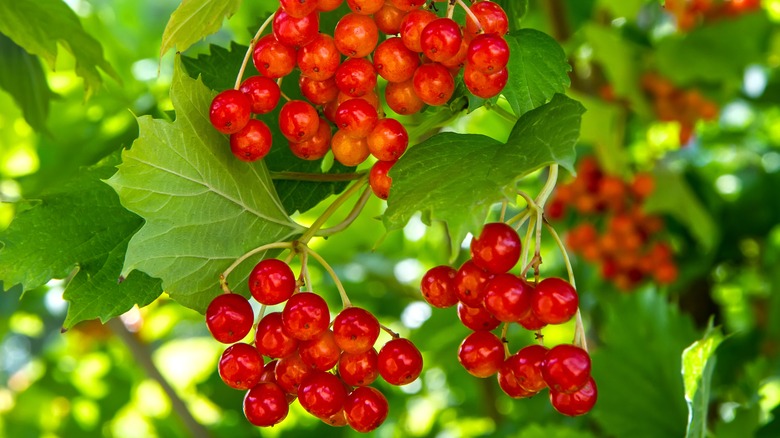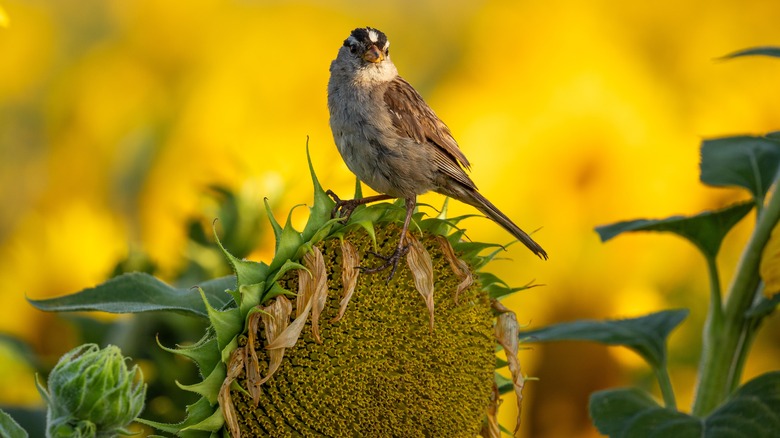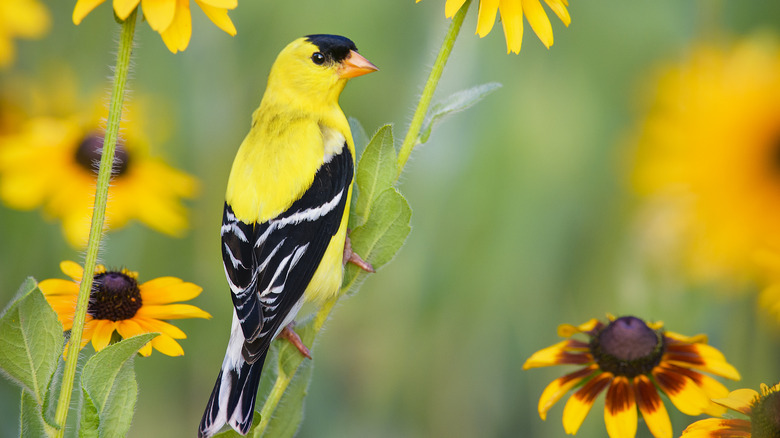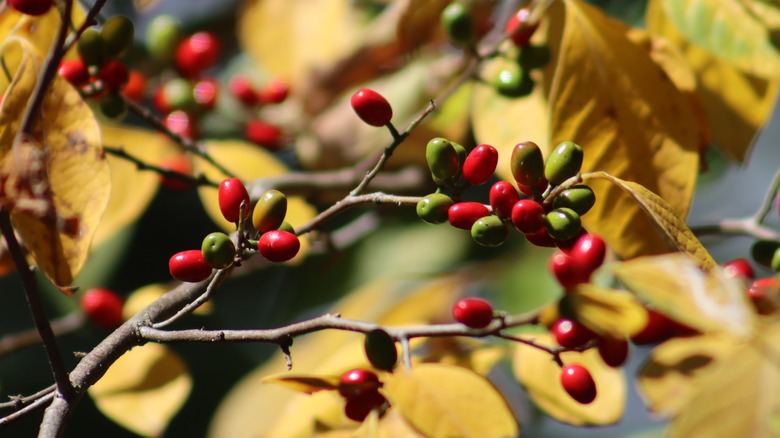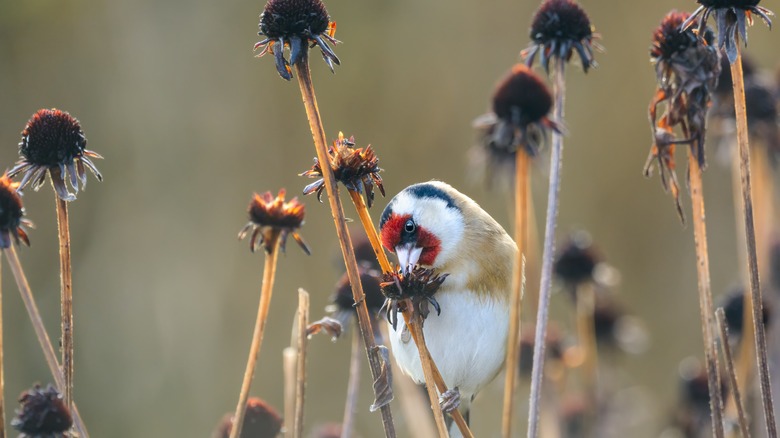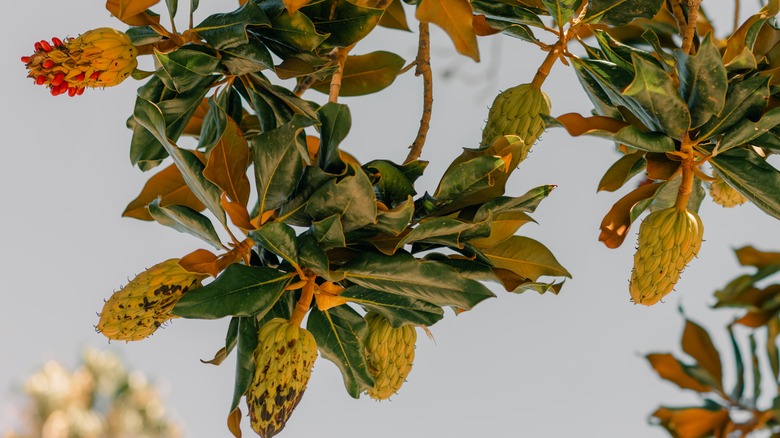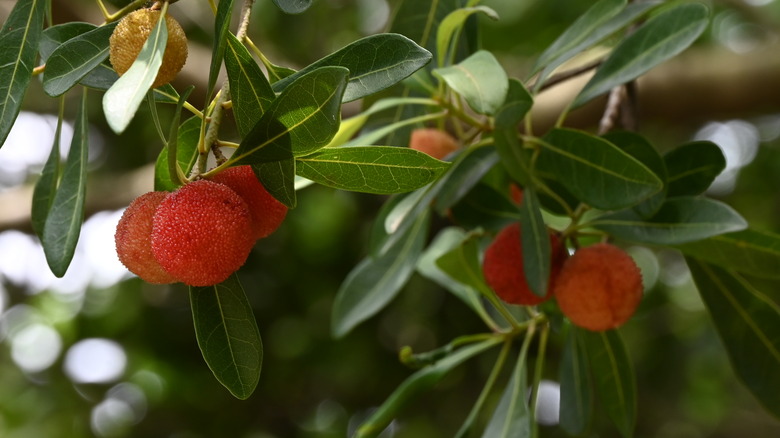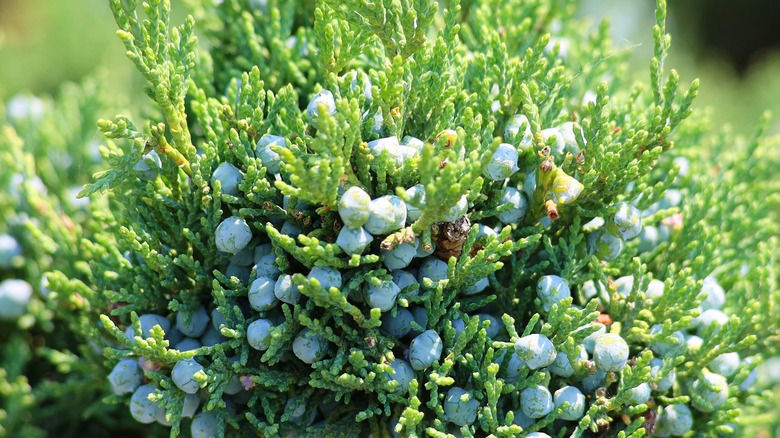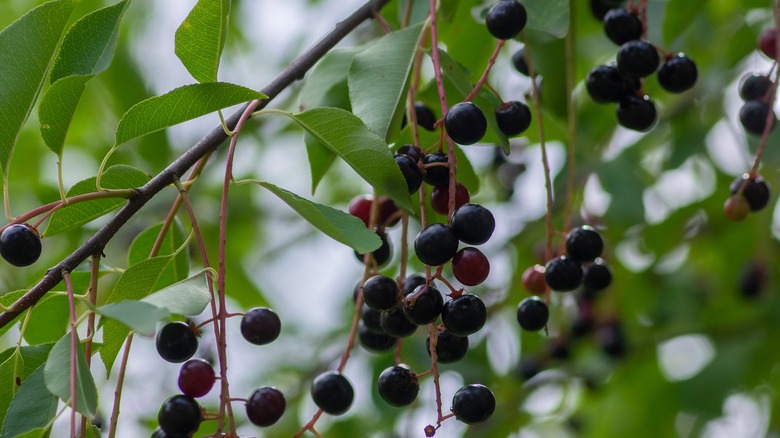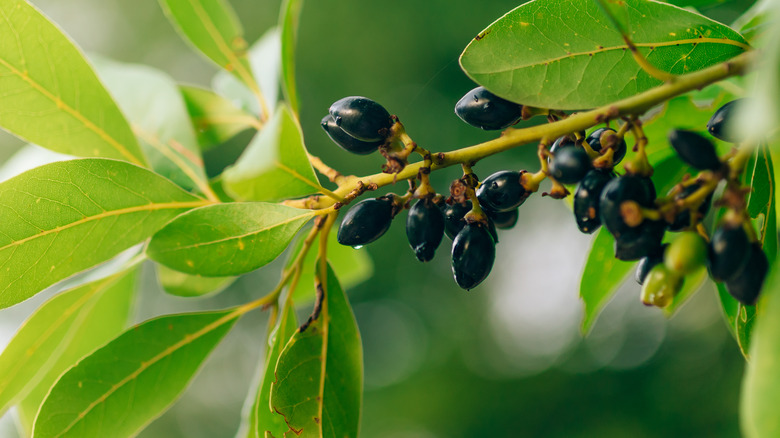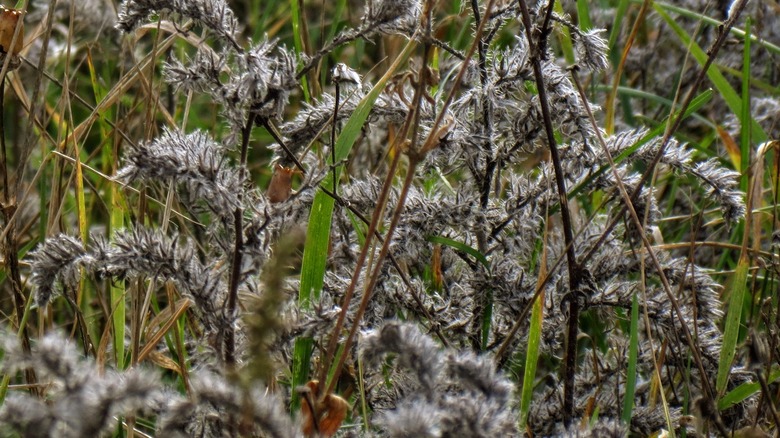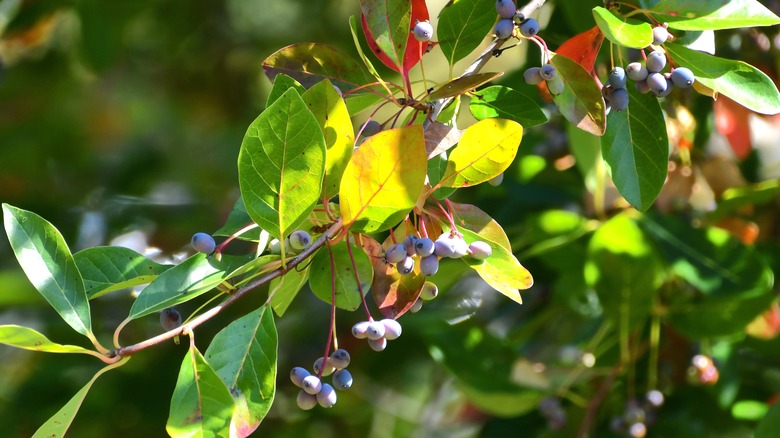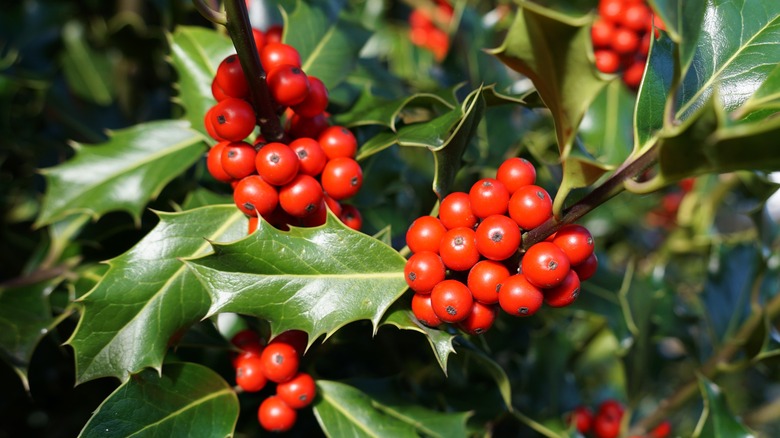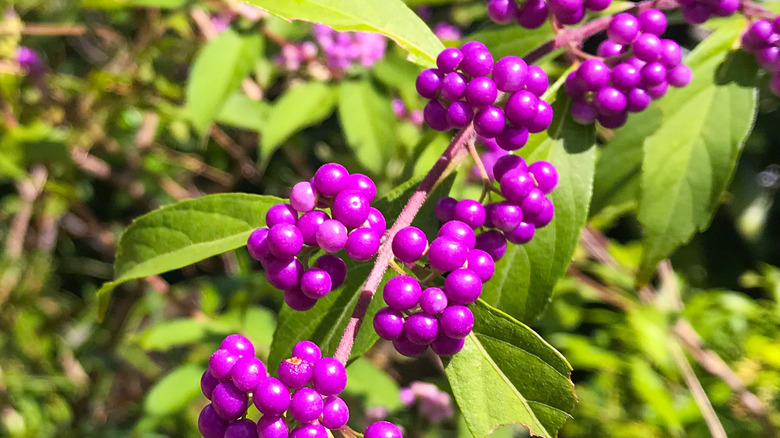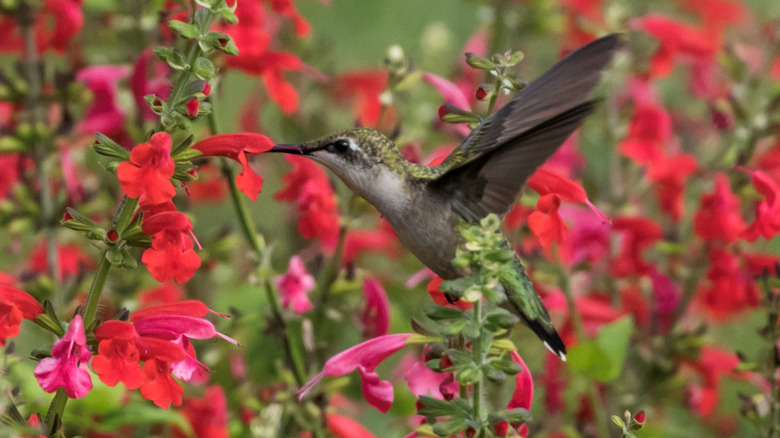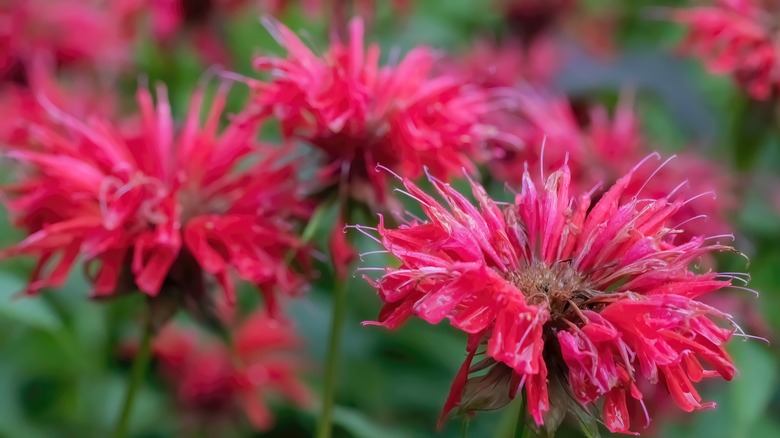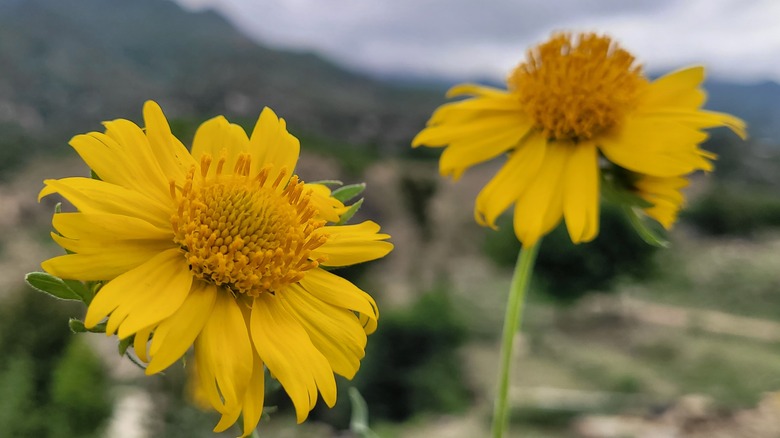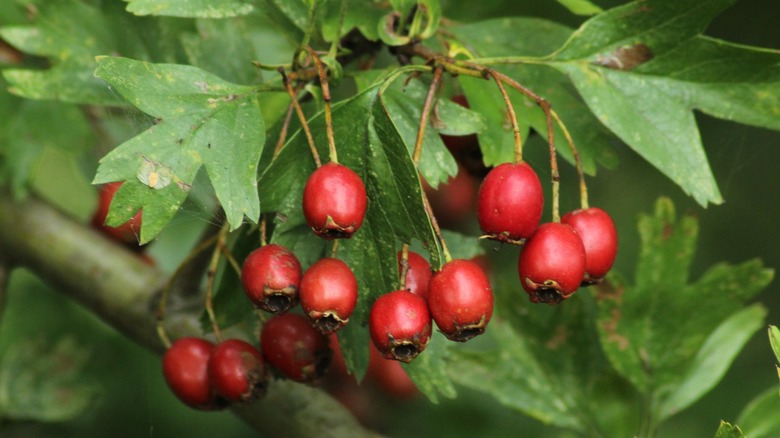18 Plant Varieties That'll Bring Fall Birds To Your Yard And Garden
We may receive a commission on purchases made from links.
Flocks of birds visiting the yard are a joy to watch and provide practical benefits to the home gardener. Birds are nature's pest control, consuming between 400 and 500 million metric tons of insects around the world each year, keeping populations of flies, ants, and aphids under control. If you want to attract more birds to your garden in the fall, you'll need to consider which elements are important to birds at this time of year. Food for wildlife is often scarce in colder months, so plants that produce late-ripening fruits for birds to eat are one way to get their attention. As temperatures drop, birds also need protection from the weather, so evergreen shrubs and bushes with dense foliage can make a garden more appealing to feathered friends. Late-flowering plants can also tempt birds, as these will attract pollinating insects for them to feast on.
When selecting bird-friendly plants for the fall garden, it's best to focus on native species, as these will do a better job of attracting native birds. Becca Rodomsky-Bish, a native plant specialist at the Cornell Lab of Ornithology, explains, "The research shows that if you can get your space to around 70% natives, then you'll see most of the benefits to birds and other wildlife." Native US plants that are a great addition to the garden include beautyberry, which will have birds flocking to feast on the bright purple berries, and hackberry, a favorite nesting spot of birds.
Viburnum
Viburnum is a gorgeous flowering shrub that thrives in the shade, and it produces berries through fall and into winter that attract a variety of birds to the garden. You can witness stunning red fruits appear on the American cranberry bush viburnum (Viburnum opulus var. americanum) that cedar wax wings and grosbeaks love. The nannyberry viburnum (Viburnum lentago) is another variety that is popular with birds, including cardinals, who feast on their blue fruits. Avoid planting the European cranberry bush (Viburnum opulus var. opulus), as they can become invasive, and birds won't show any interest in their fruits.
Sunflowers
The common sunflower (Helianthus annuus) is an easy plant to grow that will have plenty of birds flocking to your yard in fall. After blooming, the flower gives way to a mass of seeds, with a single sunflower containing as many as 2000 individual seeds. Insects are attracted to the seeds, and in turn, songbirds will be drawn to the insects. If you love seeing birds in your fall garden, sunflowers are a great call because they are known to bring sparrows, titmice, chickadees, and indigo buntings in abundance.
Black-eyed susan
Black-eyed Susan (Rudbeckia hirta) is a perennial plant that can be grown as an annual in cooler climates. It blooms in summer with bright yellow flowers that produce a wealth of seeds in fall, and birds find them simply irresistible. These seeds are known to be a favorite food of house finches and goldfinches. You could even harvest your black-eyed Susan plants and pour the seeds into a birdfeeder like this Twinkle Star Wild Bird Feeder on Amazon. This will allow you to strategically place the feeders near windows so you can enjoy watching the birds feast.
Spicebush
The spicebush (Lindera benzoin) is a deciduous shrub that produces fragrant foliage, turning from green to bright yellow in fall before dropping to the ground. The plant blooms in spring with a profusion of small star-like flowers held in clusters that give way to glossy red berries in fall. Birds such as summer tanagers and bluejays are particularly fond of these berries, which can remain on the shrub until winter. You can grow this plant in full shade, but a better fall color will be achieved when grown in the sun.
Coneflower
Purple coneflowers (Echinacea purpurea) are a beautiful addition to the summer garden because they produce attractive lilac blooms, followed by dense seed heads in fall that birds cannot resist. Finches, in particular, are known to be attracted to the seeds of coneflowers, so they are a perfect plant choice if you enjoy seeing these feathered friends in the garden. An ideal option for beginner gardeners, purple coneflowers establish themselves easily and require little care. They are drought tolerant and thrive anywhere from partial shade to full sun.
Magnolia
Though they are known for producing beautiful flowers, the red seeds of magnolia trees and shrubs (Magnolia spp.) are most interesting to birds. After blooming, the flowers are followed by seedpods, which ripen in fall and burst open to reveal delicious red seeds for hungry birds to feast on. Magnolias are among the most popular varieties of plants that attract both native and migrant birds. Most varieties of magnolia grow best in full sun, though some can tolerate partial shade. Be sure to pay attention to which type of magnolia plant is best suited to your climate.
Bayberry
The bayberry (Myrica pensylvanica) is a popular shrub amongst birds drawn to the gray-blue fruit it produces in fall and winter. During this cool period, insects can be limited, and food for birds is scarce. The late-ripening berries of the bayberry plant provide an important source of sustenance for many birds, including swallows. Bayberry is tolerant of a range of conditions once it has established itself, including full sun through to partial shade, dry and wet soils, infertile soils, and salt spray.
Eastern red cedar
The eastern red cedar (Juniperus virginiana) is one popular fruit and berry tree to grow in your yard that birds love. Cedar waxwings are so drawn to this tree that they were even named after it. Other birds you will find flocking to your garden to feast on the fleshy cones include songbirds. If you want to lure hungry birds to your yard with an eastern red cedar, be sure to plant a female tree, as these are the ones that will bear fruits known as juniper berries. The berries ripen in fall to a blue-gray color.
Hackberry
Prized as a tree that catches the eye of many birds, the hackberry (Celtis occidentalis) is a prime choice to increase the avian population in your yard. The late-ripening black fruits of these trees are known to be a favorite snack for numerous birds, including eastern bluebirds, American robins, cedar waxwings, yellow-bellied sapsuckers, and red-bellied woodpeckers. The plant is also favored as a nesting site for fall and winter birds, further increasing your chances of having feathered friends set up camp in your garden through the colder months of the year.
Sassafras
Sassafras (Sassafras albidum) trees are extremely valuable to wildlife, including birds. They produce pretty panicles of yellow flowers in early spring, followed by berries that ripen in fall. The glossy, deep blue berries are quite visually striking, hanging on bright red stems. You may not get much of a chance to appreciate the sight of the fruits, as hungry birds will quickly devour them. Though it is the female sassafras that produce fruit, you will need both male and female plants positioned close to each other to ensure cross-pollination.
Gray goldenrod
The gray goldenrod (Solidago nemoralis) attracts birds in two ways. It lures insects to its clusters of tiny yellow flowers, and these insects, in turn, will bring birds to the yard as a vital part of an avian diet. In fall, the seedheads of a gray goldenrod will gain a bird's attention, providing a source of food through the colder months when insects are harder to find. Plant the gray goldenrod in your garden and expect to see sparrows, titmice, chickadees, and indigo buntings.
Black tupelo
Black tupelo (Nyssa sylvatica), also known as black gum, is a deciduous plant native to the United States. It produces clusters of small green-yellow flowers with little aesthetic value, but they are enormously popular with bees. In September and October, the flowers are followed by black-blue berries, which represent an important source of food for migrating songbirds. The fruits are known to be enjoyed by a variety of feathered friends, including thrushes and wild turkeys. The fruits are set on female plants, but you'll need both male and female specimens for cross-pollination.
Holly
Holly (Ilex spp.) is a prime candidate for gardeners who want to attract more birds to their yards. While some plants bear fruits that are popular with birds, and some serve as a useful shelter, the holly is able to do both. It produces an abundance of glossy berries that birds find delicious. Its evergreen, dense, and often prickly foliage also makes for an ideal nesting ground that protects birds from predators and adverse weather conditions. It's easy to successfully grow and care for holly bushes. Plant them in full sun for optimum berry production.
Beautyberry
Beautyberry (Callicarpa americana) is a deciduous small to medium-sized shrub that flowers from spring and all the way through summer with blooms in shades of white, pink, and violet. By fall, an abundance of bright purple berries adorns the plant, creating garden interest in the cooler months and attracting birds and other wildlife to the yard. The berries can persist on the plant into winter when the leaves will have shed, which makes for a stunning visual. Position your beautyberry in full sun or partial shade for best growth.
Sage
Plants in the sage (Salvia) family are tremendously popular with birds, so plant these in your garden for an array of avian visitors. Hummingbird sage (Salvia spathacea), as you might have guessed, is even named after these birds that are drawn to the pollen-rich flowers. Grow sage plants, and you'll also find other bird species taking a particular interest in your fall yard, such as quail, towhees, finches, and sparrows who love to dine out on the brown seeds. As a plant with very minimal care needs, sage is an ideal addition to the low-maintenance garden.
Red bergamot
Red bergamot (Monarda spp.), also known as bee balm, is a late-blooming plant that will keep pollinators, like bees and hummingbirds, flocking to your yard in fall. The scarlet flowers flourish throughout September, attracting hummingbirds to their sweet nectar at a time when many other flowers have long perished. Red bergamot can be grown in partial shade, but for an abundant display of blooms, plant your specimen in a position that benefits from full sun. They prefer moist soil, so plant them close to a pond or stream or provide supplemental water in dry periods.
Bush sunflower
Bush sunflowers (Encelia californica), also known as California bush sunflowers, are easy-care shrubs that grow rapidly and produce masses of pretty daisy-like yellow flowers throughout the coldest months of the year. Their vivid blooms and the seeds that follow attract many birds, such as sparrows, crows, grosbeaks, and goldfinches. Inviting a plethora of birds to your yard in this way works as an eco-friendly way to keep bugs out of your garden, as birds are keen insect-eaters. The bush sunflower plant is also popular with pollinators such as butterflies.
Hawthorns
Hawthorns (Crataegus spp.) produce round, red fruits that ripen in the fall, attracting flocks of birds to the yard, including robins. Technically pomes, the fruits are commonly considered berries because of their small size. As a deciduous plant, hawthorn branches lack leaves through winter, but the scarlet haw fruits often remain for birds to feast on. Hawthorns are easy to grow and care for, tolerating various soil types as well as pollution. Though these plants can thrive in partial shade, you'll want to position them in full sun, where they will produce a greater abundance of bird-friendly fruits.
